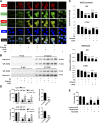RARβ acts as both an upstream regulator and downstream effector of miR-22, which epigenetically regulates NUR77 to induce apoptosis of colon cancer cells
- PMID: 30252536
- PMCID: PMC6338632
- DOI: 10.1096/fj.201801390R
RARβ acts as both an upstream regulator and downstream effector of miR-22, which epigenetically regulates NUR77 to induce apoptosis of colon cancer cells
Abstract
This study investigates the mechanism and consequences of microRNA-22 ( miR-22) induction. Our data revealed for the first time that retinoic acid (RA) and histone deacetylase (HDAC) inhibitors, including short-chain fatty acids and suberanilohydroxamic acid (SAHA), could individually or in combination induce miR-22. This induction was mediated via RA receptor β (RARβ) binding to a direct repeat 5 (DR5) motif. In addition, we uncovered HDAC1 as a novel miR-22 target. In an miR-22-dependent manner, HDAC inhibitors and RA reduced HDAC1, HDAC4, and sirtuin 1 (SIRT1), which were involved in chromatin remodeling of the RARβ and nerve growth factor IB ( NUR77). Thus, HDAC inhibitors and RA-induced miR-22 resulted in simultaneous induction of cytoplasmic RARβ and NUR77, leading to apoptosis of colon cancer cells. In mice, miR-22 and its inducers inhibited the growth of xenograft colon cancer. Moreover, tumor size reduction was accompanied by elevated miR-22, NUR77, and RARβ and by reduced HDACs. In human colon polyps and adenocarcinomas, miR-22 and RARβ were consistently reduced, which was associated with elevated HDAC1, HDAC4, and SIRT1 in colon adenocarcinomas. Results from this study revealed a novel anticancer mechanism of RARβ via miR-22 induction to epigenetically regulate itself and NUR77, providing a promising cancer treatment modality using miR-22 and its inducers.-Hu, Y., French, S. W., Chau, T., Liu, H.-X., Sheng, L., Wei, F., Stondell, J., Garcia, J. C., Du, Y., Bowlus, C. L., Wan, Y.-J. Y. RARβ acts as both an upstream regulator and downstream effector of miR-22, which epigenetically regulates NUR77 to induce apoptosis of colon cancer cells.
Keywords: butyrate; nuclear receptor; propionate; protein deacetylase; short-chain fatty acid.
Conflict of interest statement
The authors thank Dr. Prasant Kumar Jena and Nidhi Nagar (University of California, Davis Health System) for their assistance in preparation of this manuscript. This study was supported by U.S. National Institutes of Health (NIH) National Cancer Institute Grant R01CA222490 (to Y.-J.Y.W.); a Science Translation and Innovative Research (STAIR) Grant (to Y.-J.Y.W.); and National Natural Science Foundation of China Grant 81772572 (to Y.D.). The authors declare no conflicts of interest.
Figures










Similar articles
-
Enrichment of Nur77 mediated by retinoic acid receptor β leads to apoptosis of human hepatocellular carcinoma cells induced by fenretinide and histone deacetylase inhibitors.Hepatology. 2011 Mar;53(3):865-74. doi: 10.1002/hep.24101. Epub 2011 Feb 11. Hepatology. 2011. PMID: 21319187 Free PMC article.
-
Nur77 agonists induce proapoptotic genes and responses in colon cancer cells through nuclear receptor-dependent and nuclear receptor-independent pathways.Cancer Res. 2007 Jan 15;67(2):674-83. doi: 10.1158/0008-5472.CAN-06-2907. Cancer Res. 2007. PMID: 17234778
-
Rapamycin-upregulated miR-29b promotes mTORC1-hyperactive cell growth in TSC2-deficient cells by downregulating tumor suppressor retinoic acid receptor β (RARβ).Oncogene. 2019 Dec;38(49):7367-7383. doi: 10.1038/s41388-019-0957-5. Epub 2019 Aug 16. Oncogene. 2019. PMID: 31420607 Free PMC article.
-
HOXA5 acts directly downstream of retinoic acid receptor beta and contributes to retinoic acid-induced apoptosis and growth inhibition.Cancer Res. 2007 Sep 1;67(17):8007-13. doi: 10.1158/0008-5472.CAN-07-1405. Cancer Res. 2007. PMID: 17804711
-
Retinoic acid receptor beta and colon cancer.Cancer Biol Ther. 2004 Jan;3(1):87-8. doi: 10.4161/cbt.3.1.686. Epub 2004 Jan 29. Cancer Biol Ther. 2004. PMID: 14726690 Review. No abstract available.
Cited by
-
Short sleep time has a greater impact on the gut microbiota of female.Sleep Breath. 2024 Nov 28;29(1):18. doi: 10.1007/s11325-024-03193-z. Sleep Breath. 2024. PMID: 39607448
-
Recent advances in the diagnostic and therapeutic roles of microRNAs in colorectal cancer progression and metastasis.Front Oncol. 2022 Oct 13;12:911856. doi: 10.3389/fonc.2022.911856. eCollection 2022. Front Oncol. 2022. PMID: 36313731 Free PMC article. Review.
-
Retinoic acid and microRNA.Methods Enzymol. 2020;637:283-308. doi: 10.1016/bs.mie.2020.02.009. Epub 2020 Mar 28. Methods Enzymol. 2020. PMID: 32359650 Free PMC article.
-
Delineating the role of nuclear receptors in colorectal cancer, a focused review.Discov Oncol. 2024 Feb 19;15(1):41. doi: 10.1007/s12672-023-00808-x. Discov Oncol. 2024. PMID: 38372868 Free PMC article. Review.
-
The Critical Function of microRNAs in Developing Resistance against 5- Fluorouracil in Cancer Cells.Mini Rev Med Chem. 2024;24(6):601-617. doi: 10.2174/1389557523666230825144150. Mini Rev Med Chem. 2024. PMID: 37642002 Review.
References
-
- Tsuchiya, N., Izumiya, M., Ogata-Kawata, H., Okamoto, K., Fujiwara, Y., Nakai, M., Okabe, A., Schetter, A. J., Bowman, E. D., Midorikawa, Y., Sugiyama, Y., Aburatani, H., Harris, C. C., Nakagama, H. (2011) Tumor suppressor miR-22 determines p53-dependent cellular fate through post-transcriptional regulation of p21. Cancer Res. 71, 4628–4639 - PMC - PubMed
-
- Xiong, J., Du, Q., Liang, Z. (2010) Tumor-suppressive microRNA-22 inhibits the transcription of E-box-containing c-Myc target genes by silencing c-Myc binding protein. Oncogene 29, 4980–4988 - PubMed
Publication types
MeSH terms
Substances
Grants and funding
LinkOut - more resources
Full Text Sources
Other Literature Sources
Miscellaneous

